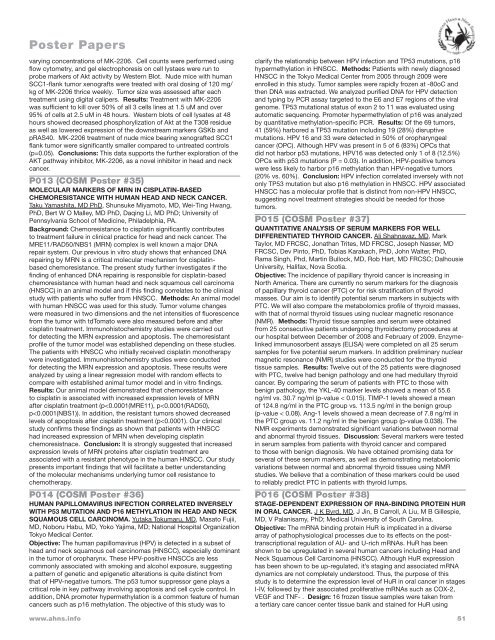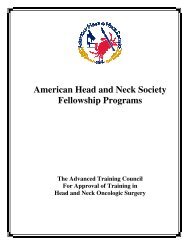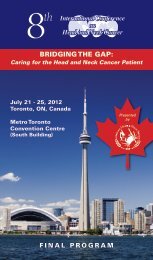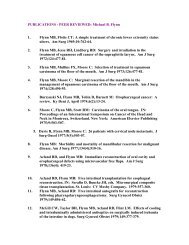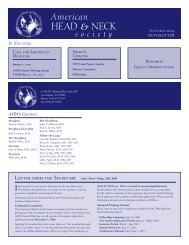Download - American Head and Neck Society
Download - American Head and Neck Society
Download - American Head and Neck Society
Create successful ePaper yourself
Turn your PDF publications into a flip-book with our unique Google optimized e-Paper software.
Poster Papers<br />
varying concentrations of MK-2206. Cell counts were performed using<br />
flow cytometry, <strong>and</strong> gel electrophoresis on cell lystaes were run to<br />
probe markers of Akt activity by Western Blot. Nude mice with human<br />
SCC1-flank tumor xenografts were treated with oral dosing of 120 mg/<br />
kg of MK-2206 thrice weekly. Tumor size was assessed after each<br />
treatment using digital calipers. Results: Treatment with MK-2206<br />
was sufficient to kill over 50% of all 3 cells lines at 1.5 uM <strong>and</strong> over<br />
95% of cells at 2.5 uM in 48 hours. Western blots of cell lysates at 48<br />
hours showed decreased phosphorylization of Akt at the T308 residue<br />
as well as lowered expression of the downstream markers GSKb <strong>and</strong><br />
pRAS40. MK-2206 treatment of nude mice bearing xenografted SCC1<br />
flank tumor were significantly smaller compared to untreated controls<br />
(p=0.05). Conclusions: This data supports the further exploration of the<br />
AKT pathway inhibitor, MK-2206, as a novel inhibitor in head <strong>and</strong> neck<br />
cancer.<br />
P013 (COSM Poster #35)<br />
MOLECULAR MARKERS OF MRN IN CISPLATIN-BASED<br />
CHEMORESISTANCE WITH HUMAN HEAD AND NECK CANCER.<br />
Taku Yamashita, MD PhD, Shunsuke Miyamoto, MD, Wei-Ting Hwang,<br />
PhD, Bert W OαMalley, MD PhD, Daqing Li, MD PhD; University of<br />
Pennsylvania School of Medicine, Philadelphia, PA.<br />
Background: Chemoresistance to cisplatin significantly contributes<br />
to treatment failure in clinical practice for head <strong>and</strong> neck cancer. The<br />
MRE11/RAD50/NBS1 (MRN) complex is well known a major DNA<br />
repair system. Our previous in vitro study shows that enhanced DNA<br />
repairing by MRN is a critical molecular mechanism for cisplatinbased<br />
chemoresistance. The present study further investigates if the<br />
finding of enhanced DNA repairing is responsible for cisplatin-based<br />
chemoresistance with human head <strong>and</strong> neck squamous cell carcinoma<br />
(HNSCC) in an animal model <strong>and</strong> if this finding correlates to the clinical<br />
study with patients who suffer from HNSCC. Methods: An animal model<br />
with human HNSCC was used for this study. Tumor volume changes<br />
were measured in two dimensions <strong>and</strong> the net intensities of fluorescence<br />
from the tumor with tdTomato were also measured before <strong>and</strong> after<br />
cisplatin treatment. Immunohistochemistry studies were carried out<br />
for detecting the MRN expression <strong>and</strong> apoptosis. The chemoresistant<br />
profile of the tumor model was established depending on these studies.<br />
The patients with HNSCC who initially received cisplatin monotherapy<br />
were investigated. Immunohistochemistry studies were conducted<br />
for detecting the MRN expression <strong>and</strong> apoptosis. These results were<br />
analyzed by using a linear regression model with r<strong>and</strong>om effects to<br />
compare with established animal tumor model <strong>and</strong> in vitro findings.<br />
Results: Our animal model demonstrated that chemoresistance<br />
to cisplatin is associated with increased expression levels of MRN<br />
after cisplatin treatment (p


